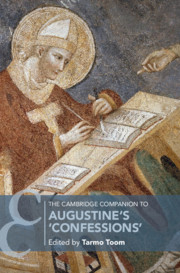Book contents
- The Cambridge Companion to Augustine’s Confessions
- Cambridge Companions to Religion
- The Cambridge Companion to Augustine’s Confessions
- Copyright page
- Contents
- Contributors
- Acknowledgments
- Abbreviations
- Introduction
- Part I Circumstances of Composition
- Part II Main Themes and Topics
- 4 Aversion and Conversion
- 5 Creation and Recreation
- 6 Sin and Concupiscence
- 7 Grace
- 8 God
- 9 Happiness and Friendship
- 10 Love, Will, and the Intellectual Ascents
- 11 Memory, Eternity, and Time
- 12 Philosophy
- 13 Pride and Humility
- 14 Soul, Self, and Interiority
- Part III Reception and Reading Strategies
- A Bibliographical Note
- Index
- Other Titles in the Series (continued from page ii)
- References
4 - Aversion and Conversion
from Part II - Main Themes and Topics
Published online by Cambridge University Press: 22 February 2020
- The Cambridge Companion to Augustine’s Confessions
- Cambridge Companions to Religion
- The Cambridge Companion to Augustine’s Confessions
- Copyright page
- Contents
- Contributors
- Acknowledgments
- Abbreviations
- Introduction
- Part I Circumstances of Composition
- Part II Main Themes and Topics
- 4 Aversion and Conversion
- 5 Creation and Recreation
- 6 Sin and Concupiscence
- 7 Grace
- 8 God
- 9 Happiness and Friendship
- 10 Love, Will, and the Intellectual Ascents
- 11 Memory, Eternity, and Time
- 12 Philosophy
- 13 Pride and Humility
- 14 Soul, Self, and Interiority
- Part III Reception and Reading Strategies
- A Bibliographical Note
- Index
- Other Titles in the Series (continued from page ii)
- References
Summary
Augustine experienced an aversio a Deo and then a conversio ad Deum. He highlights the foundational importance of conversion, which comprised both the gift of God’s grace and the responsibility of a human being. The pair aversio a Deo/conversio ad Deum constitutes a continuous dialectical process until the conversio ad Deum of human beings will find its fulfillment. To explicate this idea, Augustine often uses images, such as, the homeland and the way, the two cities, the morning and the evening.
Keywords
- Type
- Chapter
- Information
- The Cambridge Companion to Augustine's 'Confessions' , pp. 63 - 74Publisher: Cambridge University PressPrint publication year: 2020
References
Further Reading
- 1
- Cited by



